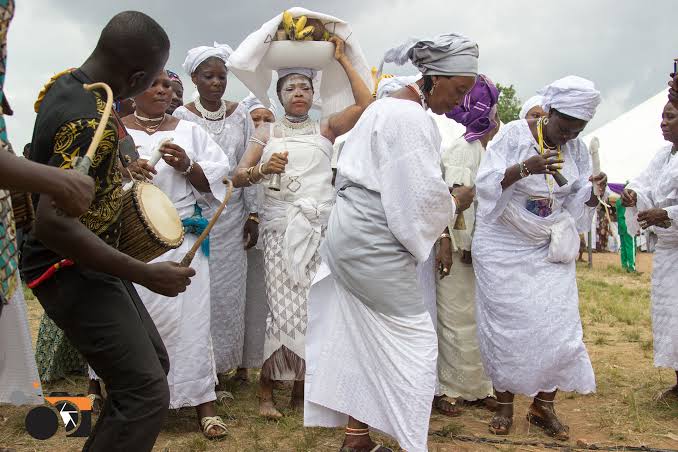The Osun-Osogbo Festival, Nigeria

The Osun-Osogbo Grove is among the last of the sacred forests which usually adjoined the edges of most Yoruba cities before extensive urbanization. In recognition of its global significance and its cultural value, the Sacred Grove was inscribed as a UNESCO World Heritage Site in 2005. The 1950s saw the desecration of the Osun-Osogbo Grove: shrines were neglected, priests abandoned the grove as customary responsibilities and sanctions weakened. Prohibited actions like fishing, hunting and felling of trees in the grove took place until an Austrian, Susanne Wenger , came and stopped the abuse going on in the grove.
With the encouragement of the Ataoja and the support of the local people, “Wenger formed the New Sacred Art movement to challenge land speculators, repel poachers, protect shrines and begin the long process of bringing the sacred place back to life by establishing it, again, as thsacred heart of Osogbo”.
Every year, the Osun-Osgogbo festival is celebrated in the month of August at the grove. Yearly, the festival attracts thousands of Osun worshippers, spectators and tourists from all walks of life.
For the people of Osogbo Land, August is a month of celebration, traditional cleansing of the city and cultural reunion of the people with their ancestors and founders of the Osogbo Kingdom.
The Osun Osogbo festival is believed to have a history of more than 700 years. Historically, an ancestral occurrence led to the celebration of this festival. Once upon a time, a group of migrating people who were led by a great hunter called Olutimehin settled on the bank of Osun river, to save themselves from famine. At the river side, Osun the goddess appeared from the water in front of Olutimehin and requested him to lead people to a special place (present Osogbo town). The goddess promised to protect all the group and bring them prosperity in return for an annual sacrifice to her. The group accepted the proposition. Today the annual sacrifice to the Osun River Goddess is what is still celebrated as the Osun Osogbo Festival.
The Osun-Osogbo Festival is a two-week-long programme. It starts with the traditional cleansing of the town called ‘Iwopopo’, which is followed in three days by the lighting of the 500-year-old sixteen-point lamp called ‘Ina Olojumerindinlogun’.
Then comes the ‘Iboriade’, an assemblage of the crowns of the past ruler, Ataojas of Osogbo, for blessings. This event is led by the sitting Ataoja of Osogbo and the Arugba, Yeye Osun and a comThe aesthetics of the Osun Osogbo festival includes drumming, dancing, musical performing, wearing of elaborate costumes, speaking of the Yoruba language, recitation of praise poetry and so on.
These elements make the festival what it is, and adding pomp and colour to the proceedings. The festival is of immense benefit to the tourism sector of Nigeria. It enables the community to sell its culture to tourist coming from both within the country and all over the world.
The aesthetics of the Osun Osogbo festival includes drumming, dancing, musical performing, wearing of elaborate costumes, speaking of the Yoruba language, recitation of praise poetry and so on.
These elements make the festival what it is, and adding pomp and colour to the proceedings. The festival is of immense benefit to the tourism sector of Nigeria. It enables the community to sell its culture to tourist coming from both within the country and all over the world.
The Osun Osogbo festival also serves as a strong unifying factor in Osogboland, as irrespective of the different social, economic, religious and political convictions of the people, they all come together annually to celebrate the goddess. Simply the best from Cometowestafrica.

